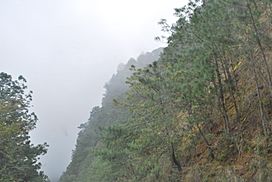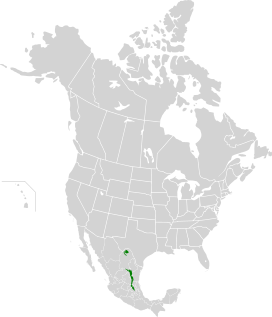Sierra Madre Oriental pine–oak forests facts for kids
Quick facts for kids Sierra Madre Oriental pine–oak forests |
|
|---|---|

Pahuatlán del Valle, Puebla state, Mexico
|
|
 |
|
| Ecology | |
| Realm | Nearctic |
| Biome | Tropical and subtropical coniferous forests |
| Borders |
List
|
| Bird species | 336 |
| Mammal species | 169 |
| Geography | |
| Area | 65,600 km2 (25,300 sq mi) |
| Countries | Mexico and United States |
| States | |
| Conservation | |
| Conservation status | Critical/endangered |
| Global 200 | Yes |
| Habitat loss | 7.6452% |
| Protected | 9.8% |
The Sierra Madre Oriental pine–oak forests are a special type of forest found in northeastern and Central Mexico. These forests also stretch a little bit into the state of Texas in the United States. They are called 'pine-oak' because they are full of pine trees and oak trees! This amazing area is home to many different plants and animals.
Contents
Where Are These Forests Found?
The Sierra Madre Oriental pine–oak forests grow high up in the mountains. You can find them at elevations from about 1,000 to 3,500 meters (3,300 to 11,500 feet) above sea level. They are part of the Sierra Madre Oriental mountain range. This mountain range runs from north to south. It sits between the Gulf Coastal Plain (near the Gulf of Mexico) on the east and the Mexican Plateau on the west. These forests also appear in the Sierra Norte de Puebla, which is close to the southern Sierra Madre Oriental. The whole forest area covers about 65,600 square kilometers (25,300 square miles).
Forest Locations and "Sky Islands"
The forests in the very south connect to another forest type called the Trans-Mexican Volcanic Belt pine–oak forests. This is in central Puebla state. The Sierra Madre Oriental pine–oak forests continue almost without a break through many Mexican states. These include Veracruz, Hidalgo, Querétaro, San Luis Potosí, Tamaulipas, Nuevo León, and northern Puebla.
North of a city called Monterrey, the forests start to break up. They become like a series of "sky islands." Imagine mountains rising up from a flatter area, with forests only on the peaks. These forest islands are found in the states of Nuevo León and Coahuila. They even reach into the Chisos and Davis mountains in the Big Bend area of western Texas. Other forest islands can be seen on the taller peaks of mountains that rise from the Mexican Plateau to the west. The forests also follow a line of folded mountains, like the Sierra de Arteaga and Sierra de Parras. These mountains stretch west across the plateau. The Sierra del Rosario, west of Torreón, is the furthest west you'll find this type of forest.
Plants of the Pine–Oak Forests
These forests are mostly made up of different kinds of pine and oak trees.
Common Tree Species
Some of the main pine trees you'll find here include:
- Nelson pinyon (Pinus nelsonii)
- Mexican pinyon (P. cembroides)
- Smooth-bark Mexican pine (P. pseudostrobus)
- Arizona pine (P. arizonica)
The most common oak trees are Quercus castanea and Q. affinis.
Other Plants
On the wetter slopes that face the ocean, you'll often see Mexican pinyon and Juniperus deppeana. On the drier western slopes, weeping pinyon (Pinus pinceana) is more common. These forests are also home to many other plants, including agave and plants that people have traditionally used for food.
Animals of the Pine–Oak Forests
This ecoregion is a lively place for many different animals, especially mammals and birds.
Mammals and Their Habitats
Many mammals live in these forests. Some of them include:
- American black bear (Ursus americanus): These bears travel along the Rio Grande from northern Coahuila to the Chisos Mountains in Texas.
- Mule deer (Odocoileus hemionus)
- Cougar (Puma concolor)
- Cliff chipmunk (Tamias dorsalis)
- Collared peccary (Pecari tajacu)
- White-nosed coati (Nasua narica)
- Jaguar (Panthera onca)
- Coyote (Canis latrans)
Birds and Their Life Cycle
The Sierra Madre Oriental pine–oak forests are very important for birds. Two special birds that live only in this ecoregion are:
- The maroon-fronted parrot (Rhynchopsitta terrisi)
- The Colima warbler (Vermivora crissalis)
Other birds that live here include:
- Wild turkeys (Meleagris gallapavo)
- Peregrine falcons (Falco peregrinus)
- Golden eagle (Aquila chrysaetos)
Monarch Butterfly Migration
The pine–oak forests in Coahuila are a key part of the migration route for monarch butterflies (Danaus plexippus). These amazing butterflies travel thousands of miles!

